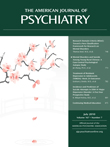To the Editor: Dr. Baumeister has argued that in diagnosing subsyndromal depression, raising the distress threshold of the clinical significance criterion substantially reduces prevalence, preventing false positive diagnoses of normal distress (1). In his letter, he observes that our article’s seemingly contrary finding that the clinical significance criterion’s distress component had little impact on subsyndromal diagnosis was because of the very broad DSM-IV-based criterion of the National Comorbidity Survey Replication. Moreover, we too reported that higher distress thresholds may eliminate many cases. Unlike the redundancy of DSM-IV’s clinical significance criterion with major depression symptoms, a high-threshold clinical significance criterion is not redundant with subsyndromal depression’s more limited symptoms.
Further analysis supports the contention that raising clinical significance criterion distress thresholds substantially reduces subsyndromal depression prevalence. The National Comorbidity Survey Replication liberally allowed positive answers to any of four questions to establish distress, and the threshold was “moderate/sometimes.” Our analysis included all non-major depression sadness cases (N=817), a heterogeneous mix. To more closely examine Dr. Baumeister’s claim, we reanalyzed the data, including only respondents reporting sadness plus between one and three additional symptoms (N=241), using one-item criteria. For the item, “severity of emotional distress during sad episode,” moving the threshold from “moderate” to “severe” reduced the rate of prevalence in the sample from 85% to 34% (if “very severe,” to 7%). Using the more stringent item “emotional distress so severe could not carry out activities,” moving the threshold from “sometimes” to “often” reduced the rate of prevalence from 21% to 5%.
How thoroughly such increased thresholds eliminate false positives remains uncertain because the symptoms’ context is ignored. Even severe distress after major losses may not indicate mental disorder. But, context aside, we agree with Dr. Baumeister’s contention that higher subsyndromal depression distress thresholds substantially impact prevalence and plausibly help to fix a serious false positives problem.
If this conclusion is correct, then proposed DSM-5 criteria for “depressive conditions not elsewhere classified” must be reconsidered. The proposal allows diagnosis of subsyndromal depression (sadness and one or more other symptoms lasting 2 weeks) that causes distress or role impairment. No distress threshold is specified (even mild distress qualifies), and symptom intensity thresholds are waived. This is considerably broader than the National Comorbidity Survey Replication/DSM-IV clinical significance criterion. Our analysis indicates that depending on the item used, between one-third and one-twentieth of subsyndromal depressions satisfy a higher threshold clinical significance criterion distress component, a more plausible approach to diagnosis of sadness with minimal accompanying symptoms in our view.
Consequently, the validity of DSM-5 subsyndromal depression criteria could be increased by requiring, for example, “persistent severe distress, persistent frequent disruption of normal activities, or other indicators of pathological dysfunction.” Those suffering from intense sadness should be offered help, but misdiagnosing normal sadness as a disorder can lead to the wrong kind of help.

